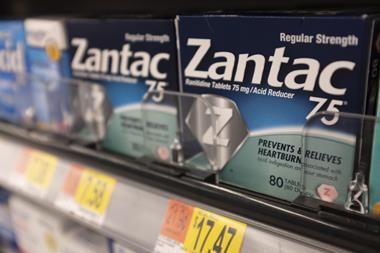On 5 March, Valisure, an independent testing laboratory in the US, submitted a Citizen Petition to the US Food and Drug Administration (FDA) requesting the recall and suspension of sales of benzoyl peroxide products used to treat acne.
Valisure had detected high levels of benzene – a known human carcinogen – in many benzoyl peroxide products in the US. It said that the current evidence suggested that on-market benzoyl peroxide products could produce substantial amounts of benzene when stored at above ambient temperatures.
But what does this mean for the many products this could potentially affect?
What is benzoyl peroxide?
Organic peroxides are organic compounds that contain two adjacent oxygen atoms linked by a single bond. This bond can break easily forming free radicals – highly reactive chemicals that have an unpaired electron.
Benzoyl peroxide is made up of two benzoyl moieties linked by a peroxide and is commonly used as a solvent in industry but it is also an effective acne treatment. As a powerful bactericide, benzoyl peroxide inhibits the growth of Cutibacterium acnes, the main bacterium associated with acne. As a result, it can reduce the number and severity of acne lesions but, unlike antibiotics, it has not been associated with resistance. Acne treatments usually contain between 2.5% and 10% benzoyl peroxide.
What testing did Valisure carry out?
It has been known for decades that benzoyl peroxide has the potential to thermally decompose into benzene, which is a known carcinogen. Consequently, Valisure decided to carry out a variety of tests on prescription and over-the-counter products containing benzoyl peroxide.
Initial GC-MS analysis on 99 benzoyl peroxide-containing acne medication products led to the detection of benzene in 94 of them. These findings led Valisure to conduct a stability study at elevated temperatures on a range of benzoyl peroxide products (creams, lotions, gels, washes, liquids and bars).
First the researchers did an initial study with five benzoyl peroxide products to test the effect of different temperatures (37°C, 50°C and 70°C) on the stability of the product. They said this test revealed that dozens of parts per million (ppm) of benzene could form in just a few weeks at 37°C, hundreds of ppm at 50°C and the product packaging would often burst at 70°C (which Valisure said was within the reported temperature range of a hot car).
Based on this initial study, the company chose 50°C as the stability temperature for a broader study of 66 products containing benzoyl peroxide. It said this was a ‘reasonable temperature’ that the product could be exposed to during distribution and handling by consumers.
The products were incubated at 50°C for 18 days and tested for benzene at regular intervals. In the majority of products, the levels of benzene appeared to be higher at day 18 than at day 0. For example, the results for 10% Clearasil cream suggested it had less than 10ppm of benzene on day 0 and over 300ppm on day 18, while 10% PanOxyl Cream had fewer than 10ppm of benzene on day 0 and more than 150ppm on day 18.
Valisure said that the results showed the ‘substantial instability’ of benzoyl peroxide and its propensity to form ‘concerningly high levels’ of benzene in only 18 days.
Other acne treatment products tested by Valisure, such as those containing salicylic acid or adapalene, do not appear to have this problem.
How harmful is benzene?
Benzene is known to cause some types of leukaemia and potentially other cancers. The International Agency for Research on Cancer has therefore classified benzene as carcinogenic.
In day-to-day life, our exposure to benzene is most likely to occur through inhalation; it is a common air pollutant in vehicle exhaust and cigarette smoke.
As with exposure to any chemical, potential adverse health effects depend on several factors, including the amount an individual is exposed to, the way they are exposed and the duration. The Environmental Protection Agency (EPA) estimated that daily exposure to benzene at 0.4 parts per billion (ppb), or 0.0004ppm, will result in an increased cancer risk of one additional case per 100,000 people over a 70-year lifetime. This is the same method the FDA uses to set regulatory limits on other trace impurities like N-nitrosamines.
FDA guidance states that benzene should not be used in the manufacture of drugs because of its toxicity. However, it says that if the use of benzene is unavoidable to produce a drug product with a significant therapeutic advance, levels should be restricted to 2ppm.
Has benzene been found in anything else?
Valisure has detected benzene in many drug and consumer products since 2021, including hand sanitiser, sunscreens and body sprays. In 2021, companies including Johnson & Johnson, Unilever and Procter & Gamble recalled products due to the presence of benzene. But, according to Valisure, in these instances, the benzene came from contaminated ingredients, rather than the benzoyl peroxide itself.
Valisure’s methods have previously been questioned by the FDA, however, who highlighted ‘methodological deficiencies’ and ‘analytic discrepancies’ in the company’s testing. It is also worth noting that the president of Valisure, David Light, is listed as an inventor on a patent filed in 2023 for a method to prevent benzoyl peroxide from breaking down into benzene in drug products.
What have manufacturers said?
Chemistry World reached out to manufacturers who make products containing benzoyl peroxide, including Estée Lauder, L’Oréal and Reckitt.
Reckitt responded that it was confident that all of its Clearasil products, when used and stored as directed, were safe. ‘Clearasil products and their ingredients are stable over the storage conditions described on their packaging which represent all reasonable and foreseeable conditions. The findings presented by an independent lab reflect unrealistic scenarios rather than real-world conditions.’
Should we be concerned?
The findings of Valisure’s study certainly warrant further investigation and suggest that users of these products should be mindful of how they store them. But it is important to acknowledge that in most cases people are not storing benzoyl peroxide at the high temperatures used in the study for such a sustained length of time.
In addition, the report does not detail if benzene formation is observed with appropriate storage as indicated on product packaging.
There may also be opportunities for reformulation of some products to reduce the risk – for example, using antioxidants to help stabilise benzoyl peroxide products could be a useful strategy to improve the stability of these products.
The FDA told Chemistry World it acts on information provided from a variety of sources, such as that provided by Valisure, but that data must be verified as accurate and reproducible before making any regulatory decisions, such as product sale suspensions and recalls.
‘The agency will continue to provide updates to the public regarding benzene in drug products, as appropriate,’ it added.
The FDA has previously alerted drug manufacturers to the risk of benzene contamination from drug components and other potential risk factors and is evaluating the root cause of benzene contamination in certain drugs.

















1 Reader's comment